Apple got tablets right, and created a whole new market with the iPad
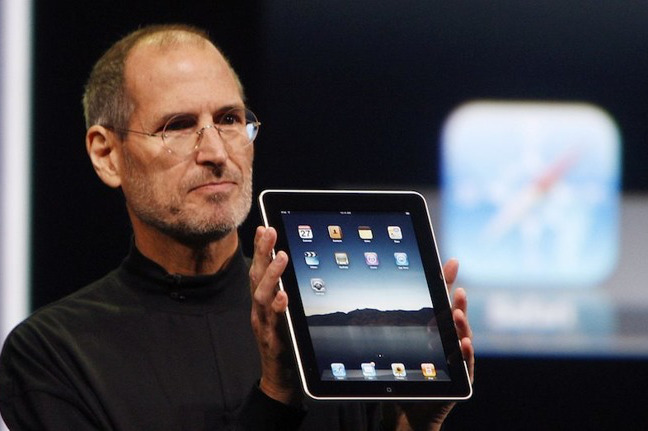 In the last few months before the much, much anticipated iPad was launched on January 27, 2010, competitors had been talking up their own tablets. Then suddenly it was rumored that Apple’s one was going to be called the iSlate and competitors such as Microsoft were calling everything they could ‘slate PCs.’
In the last few months before the much, much anticipated iPad was launched on January 27, 2010, competitors had been talking up their own tablets. Then suddenly it was rumored that Apple’s one was going to be called the iSlate and competitors such as Microsoft were calling everything they could ‘slate PCs.’
Three days before the iPad was announced, Microsoft’s then-CEO Steve Ballmer even unveiled three such slate PCs. He did so in his typical hesitant, clunky style and launched a video that was over practically before he’d introduced it.
Given that and the way he belabored that all the slate PCs he showed were prototypes, it all felt a little desperate. Apple was coming, it seemed to say, and rivals were afraid.
Microsoft, for one, should really have been feeling chagrin. As far back as 1996, its founder Bill Gates wrote in his book The Road Ahead that “in the future lots of people will be taking handwritten notes on computer tablets rather than paper.”
True, by then we’d already seen the Apple Newton so Gates’s book wasn’t as visionary as it seemed to think. However, Microsoft had done more than talk about tablets, it had released Microsoft Windows for Pen Computing in 1992. Then by the early 2000s, companies were making Pocket PCs.
Microsoft had tablets long before Apple. Many, many companies had tablets. It was just that nobody was buying them.
So this is where we were in early 2010. The entire computing industry was waiting for an Apple tablet, the world’s press was going to cover its launch. And then, as now, Apple didn’t say a word about what was coming.
The earliest official indication of something, anything, happening came on January 18, 2010, when Apple issued a press invitation to the launch. It was less cryptic than usual as it blatantly said: “Come see our latest creation.”
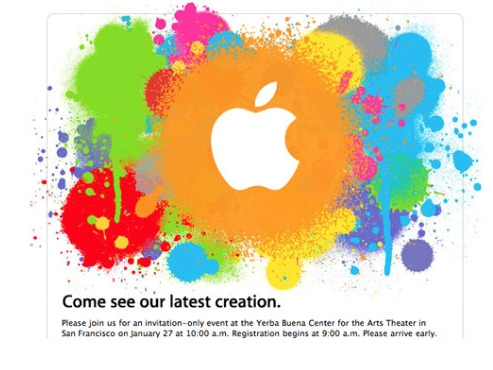
Apple’s invitation to what would be the launch of the iPad
At 10am Pacific on Wednesday, 27 January, 2010, Steve Jobs stepped out onto the stage at the Yerba Buena Center for the Arts, San Francisco. He didn’t pause the way he had with the iPhone three years before. He didn’t say that this was a day he’d been waiting for.
Yet he could have done because as we found out much later, the story of the iPad began much earlier. It began earlier even than the iPhone.
Origin story
You know that the Newton was Apple’s first tablet computer, albeit one that needed you to use a stylus instead of your fingers. It’s debatable whether there is really a line from the Newton MessagePad to the iPad but if this were a case of evolution, we’ve found the missing link.
That 2012 video is a demonstration of a pen-based Mac that was made around 1992 but never shipped as a commercial product in the US. It was called the Apple Penlite and the version shown here is a stylus-based tablet version of the Macintosh PowerBook Duo.
Reportedly, though, there was also a version that ran with what we would now call multi-touch gestures.
Apple dropped that and it dropped the Newton but in 2004 Steve Jobs revealed that Apple had continued looking at a PDA. “We got enormous pressure to bring back the Newton or do a PDA and we looked at it,” he said at the D2 All Things Digital Conference. “And we said, wait a minute, 90 percent of the people who use these things just want to get information out of them, they don’t necessarily want to put information into them on a regular basis. Cellphones are going to do that.”
At the time, he said this as if that were the end of it, that cellphones were a market that Apple could never compete in. Yet by this moment in 2004, Apple had produced a technology that would end up becoming the iPhone. It’s just that it wasn’t looking at a phone then, it was looking to do a tablet.
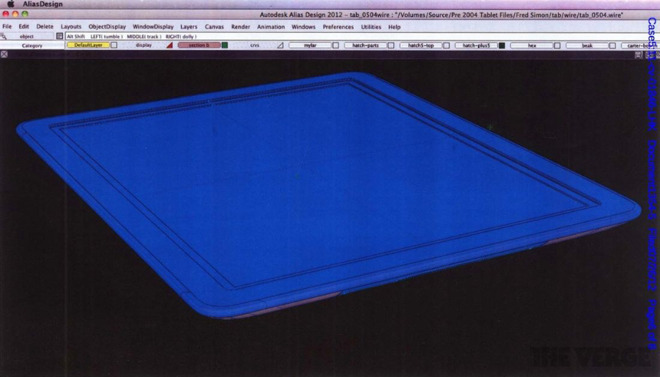
CAD drawings from 2004 of the iPad (Source: The Verge)
That image and others were later to be used as exhibits in an Apple vs Samsung court case where we also saw photographs of later prototype iPads.

It’s odd just how unclear and uncertain the origins of the iPad are given that it and the iPhone are so important to Apple and that none of this was so very long ago. Yet while the CAD drawings show a date of 2004, Walter Isaacson claims in his Steve Jobs biography that the idea for the iPad didn’t come until 2005.
Even then he recounts two different versions. One is that Jony Ive and his team had been working on improving the trackpads of the MacBook Pro when they developed multi-touch. Ive showed Jobs a version of their attempt to move multi-touch onto a screen. Isaacson reports that Jobs then said that “this is the future.”
Alternatively, Isaacson also recounts a version that sounds more colorful and apocryphal but which he backs up with quotes from Jobs and Bill Gates. Reportedly Gates and Jobs were at a dinner party for the birthday of a Microsoft engineer who, says Jobs, “badgered me about how Microsoft was going to completely change the world with this tablet PC software.”
Apparently this wasn’t a new topic for this unnamed Microsoft engineer —”this dinner was like the tenth time he talked to me about it” —but each time the conversation was about using a stylus. “But he was doing the device all wrong,” continued Jobs. “As soon as you have a stylus, you’re dead… I was so sick of it that I came home and said ‘F*** this, let’s show him what a tablet can really be.'”
What is clear that this work to make a tablet was changed into making a phone. We know this from how Jobs, Ive and others have said so, but also from the fact that it happened. The iPhone came out in 2007 and it wasn’t until 2010 that the tablet appeared.
It’s not as if the road from idea to tablet was easy but once the iPhone was done, and also was such an overwhelming success, the iPad was at least more assured.
Except that Apple was new to tablets and so many other companies had tried and failed. The iPad’s success was of course going to be down to its technology but also very much to how Apple positioned it.
And as much as unveiling the hardware on January 27, 2010, Jobs was really selling us on the idea of an iPad.
Showman
Steve Jobs got a standing ovation when he stepped out onto that Yerba Buena Center for the Arts stage and he got it before he even said “Good morning.” He got the welcome because this was his public return to Apple after having taken six months leave while recovering from a liver transplant.
The extent of applause did seem to surprise him and he did still look ill, but he was soon into a very astutely prepared presentation.
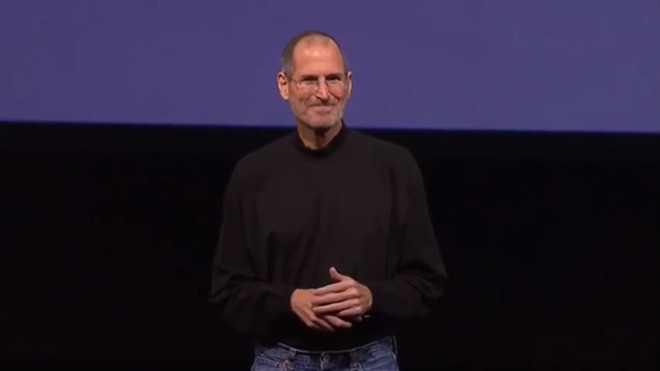
Steve Jobs on stage for the first time after his liver transplant operation
Twice he teased about being there to show us all something new and then instead said he wanted to tell us other things first. He gave a typical update on the state of Apple and of course the numbers were impressive, or at least they were at the time.
While they’ve now all been dwarfed by the company’s later success, in January 2010 Jobs was able to report that the company had sold its 250 millionth iPod. He was able to say that there were 284 Apple Stores and that they’d seen 50 million visitors in the last quarter. He could tell us that there were now over 140,000 applications in the App Store and that they’d been downloaded over 3 billion times.
It was all the regular stuff but in this presentation it was specifically laying the ground work for how Apple was the company to deliver a tablet. How it was the firm that would of course get this right.
After the numbers about the stores, Jobs showed an image of himself and Steve Wozniak from the earliest days of Apple and then paused. “We started Apple in 1976,” he said. “Thirty-four years later, we just ended our holiday quarter, our first fiscal quarter of 2010, with $15.6 billion dollars of revenue. That means Apple is an over-50 billion dollar company. Now, I like to forget that because that’s not how we think about Apple but it is pretty amazing.”
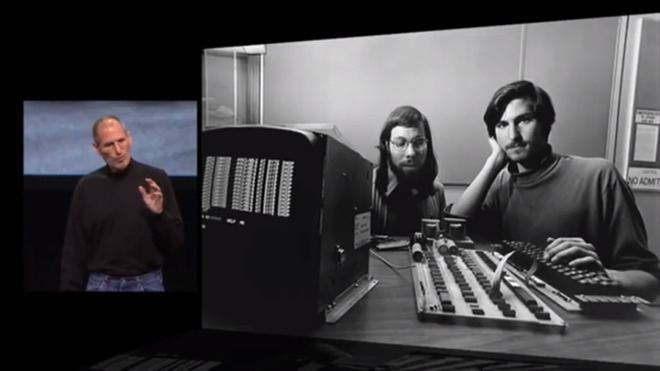
Steve Jobs recalls forming Apple with Steve Wozniak
It was also the cue for him to expand on the revenue number, to talk to us about how Apple gets this from three product lines. Those were the iPod, iPhone and the Mac.
“Now what’s really interesting about this is that iPods are mobile devices,” he said. “iPhones are mobile devices. And most of the Macs that we ship now are laptops. They’re mobile devices. Apple is a mobile devices company, that’s what we do.”
Remember that competitors had been making tablets for at least a decade. Here was Steve Jobs saying that Apple was bigger and better than them all. “It turns out that by revenue, Apple is the largest mobile devices company in the world now.”
He belabored the point, driving home that Apple was larger than Sony —or at least that company’s mobile devices business —and the same with Samsung and Nokia.
With us all now fully briefed on Apple’s stature in the mobile devices market, he finally went into the iPad part of the presentation. Or appeared too.
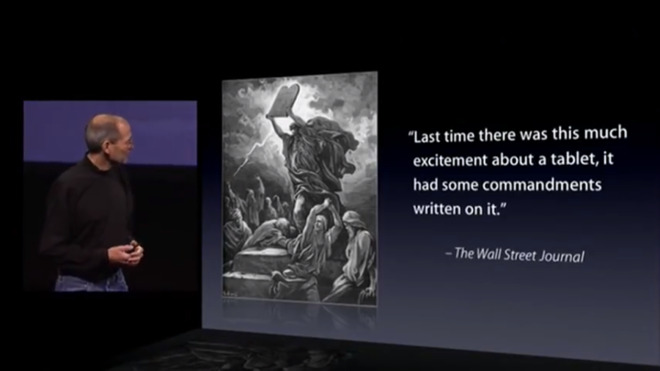
Jobs quotes the Wall Street Journal on the hyped-up rumors of an Apple tablet
“But before we get to that,” he said to laughter, “I want to go back to 1991 when Apple announced and shipped its first PowerBooks.”
Now he was underlining Apple’s hardware expertise and how it led the industry. He spoke of how the PowerBook made the laptop into what we now recognize as one. “It was the first laptop that had a TFT screen the first modern LCD screens. It was the first laptop that pushed the keyboard up, creating palm rests and had an integrated pointing tool, in this case a trackball.”
Amazingly, we’re only just over six minutes into this presentation but Jobs has primed us to think that Apple is the best mobile devices company in the world and also the best at making laptops.
And finally, it was here.
“A question has arisen lately,” said Jobs. “Is there room for a third category of device in the middle? Something that’s between a laptop and a smartphone. The bar is pretty high. In order to really create a new category of devices, those devices are going to have to be far better at doing some key tasks. They’re going to have to be far better at doing some really important things. Better than the laptop. Better than the smartphone.”
He sketched out some tasks like browsing the web, doing email, reading.
“If there’s going to be a third category of device, it’s going to have to be better at these kinds of tasks than a laptop or a smartphone. Otherwise it has no reason for being. Now, some people have thought that that’s a netbook. The problem is that netbooks aren’t better at anything.”
He dismissed netbooks for their lack of speed, lack of quality and poor software. He said they’re “just cheap laptops and we don’t think that they’re a third category of device.”
And then he said “But we think we’ve got something that is and we’d like to show it to you today for the first time. And we call it the iPad.”
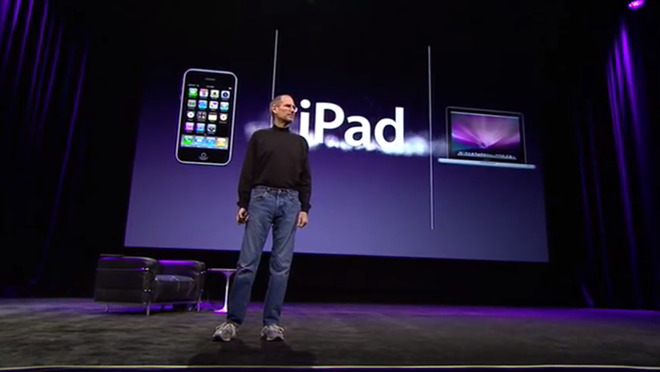
The first time we saw the word iPad
It’s as well that Jobs had done all this work positioning the iPad because just about the instant that slide appeared, so did the first criticisms of the device. The very first criticism, though, was valid. It was about the name iPad.
Among many references online to Maxi-Pad tampon and among Twitter references to #iTampon, there were criticisms that clearly no women work in Apple’s naming department. Fast Company‘s Alissa Walker or perhaps her headline writer said it best, though, in a piece called “Apple’s iPad Name Not the First Choice for Women. Period.”
Slated
If you got an original iPad when it actually went on sale in April that year, your first reaction was surprised at how small it was. Then after a few minutes of using it, you tended to forget that and even come to think the opposite. Seeing a full website page at a time did feel like, as Jobs said, “holding the internet in your hands.”

Look at the bezels on the original iPad
The majority of critics did not wait to get one, did not wait for it to go on sale, before they were pronouncing the iPad a certain flop.
Business Insider called it “a big yawn” and a disappointment, saying that Jobs “didn’t deliver.”
InfoWorld didn’t even wait for the announcement, let alone the product, before it went a bit crazy with the idea of a “coming Apple tablet-pocaplypse.” Written for IT professionals in corporations, it advised “an outright ban [on the iPad] is in order.” It even told them to make any excuse they liked but ban the iPad and “seek to contain the situation by offering up an alternative tablet solution running the IT-supported and IT-approved Windows 7 operating system.”
John C Dvorak was always more of a clickbait and shock-jock style of pundit but he at least waited until the announcement, even if he didn’t see an iPad himself. Still, he reckoned it was a serious misstep. “I’m of the opinion and hope that this device is only released as a market test and placeholder for something more spectacular in the future,” he wrote.
Spectacular future
If Dvorak’s notion of a market test was bizarre for a business writer, you could say that he was right that something more spectacular would be coming in the future.
Despite the critics, despite being late to the whole idea of tablets, Apple made the iPad and we bought it in our millions. It’s had some ups and downs since that 2010 launch but it’s also got progressively more spectacular.
You’ve seen how shockingly huge the bezels on the original model now seem to us. Here’s another way to see the difference between then and now.
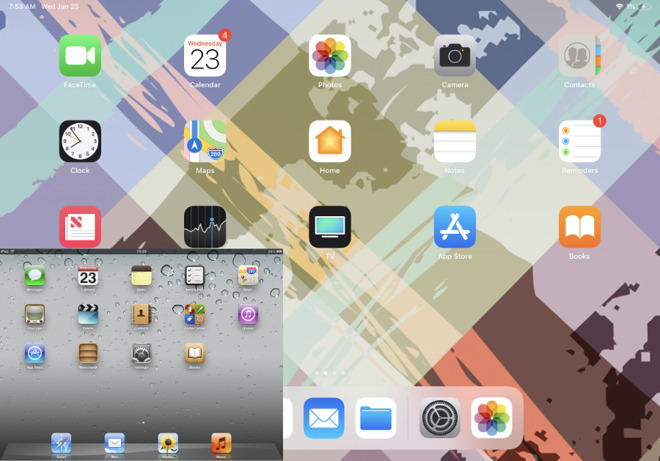
Main image: 2018 11-inch iPad Pro home screen. Inset, to scale: original iPad home screen
The main image is a home screen from the current 11-inch iPad Pro. The two devices have slightly different dimensions. The original iPad was 9.56 inches by 7.47 inches and the 2018 model is 9.74 inches by 7.02 inches.
However, look at the inset image. That’s the home screen of an original iPad and it’s rendered here to scale. This is how far just the quality of the iPad screen has come since January 27, 2010, when Jony Ive said that the iPad was “magical”
[“source=appleinsider”]